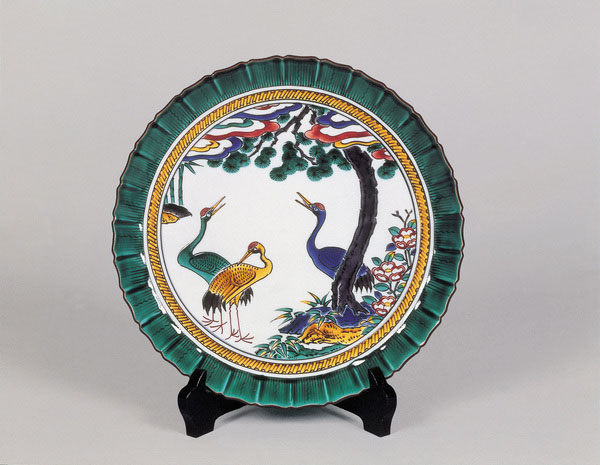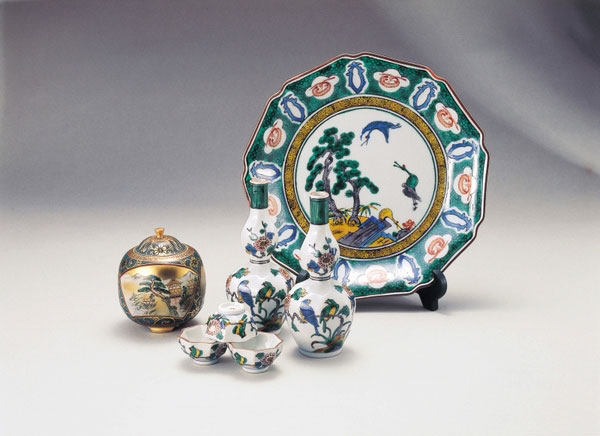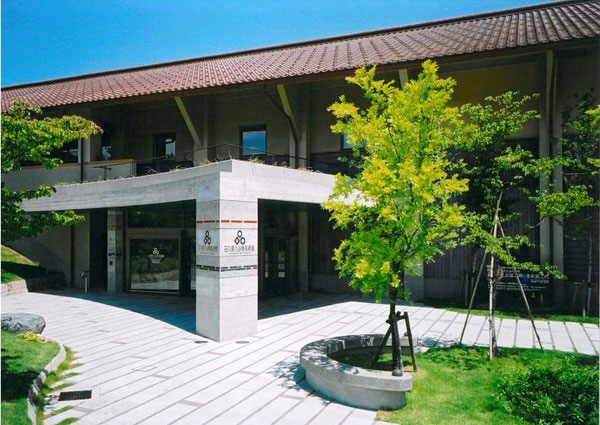 Photo:Ishikawa Prefecture Tourism League
Photo:Ishikawa Prefecture Tourism League
- Ceramic
- Ishikawa
Kutani ware Kutani yaki
A powerfully depicted world of flowers, birds, and landscapes
in five vivid colors (green, yellow, red, purple, and Prussian blue)
Description
What is Kutani ware ?
Kutani ware (called Kutani yaki in Japanese) is a type of pottery manufactured in and around the city of Kaga in Ishikawa prefecture. It is a traditional handicraft that was first produced during the early Edo period (beginning of the 17th century). Kutani ware's notable features are vivid colors, bold and elegant designs, and a particular technique of overglaze decoration. This technique consists of using pigments to paint a pattern on the glazed surface and then firing the piece again. Because the paint used for the overglaze can be fired at about 800℃ (about 1472℉), there is a wide variety of colors that can be used. This technique is used for other crafts such as Arita ware as well. Kutani ware are all very colorful but the colors used differ depending on the type of pottery. Both kokutani and mokubeifu use five colors (red, yellow, green, purple, and Prussian blue), commonly referred to as Kutani gosai (literally, "the five Kutani colors"). Yoshidayafu is beautiful with four vivid shades of blue, yellow, purple, and Prussian blue. The red used in iidayafu is striking and distinctive. Eirakufu is characterized by its elegant pairing of red and gold. Finally, shozafu combines multiple pottery techniques into an impressive well-balanced ceramic.
History
 Photo: Ishikawa Prefecture Tourism League
Photo: Ishikawa Prefecture Tourism League
The beginning of Kutani ware dates back to 1655. The handicraft was named after the village where it was first produced, Kutani, which was then in the domain of a feudal lord. The lord sent a man named Saijiro GOTO to learn ceramic-making techniques in the town of Arita. When Goto got back, he established a Kutani ware kiln and incorporated the techniques from Arita but it eventually fell into disuse after half a century. The circumstances of what led to the abandonment of the kiln are unknown, but there is a theory that it was due to suspicions of smuggling. The ceramics produced in this short time period are called kokutani and have gorgeous colors and distinctive designs. About 100 years after abandonment of the kiln, the production of Kutani ware started again with support from the feudal domain. First, production of mokubeifu started in 1807 when a famous painter, Mokubei AOKI, was invited from Kyoto and established the Kasugayama kiln. Then several styles of Kutani-ware were created: yoshidayafu in 1827; iidayafu in 1831; shozafu in 1841 and eirakufu in 1865.
General Production Process
- 1. Crushing pottery stone First, the raw material of pottery stone is mined and crushed to a powder using a pulverizer. As the powder from crushed pottery stone cannot be used until impurities are gone, water is added to the powder and is strained to remove the impurities. Once the impurities have been removed and the excess moisture has evaporated, the clay is kneaded to remove air bubbles. Then the clay is ready.
- 2. Shaping the form Some of the methods that can be used to create a form are throwing the clay onto a potter's wheel, shaping it into a coil, and building from a flat slab. Detailed finishes such as trimming of the base, making knobs, and pattern carving are done after the form has been created. When possible, the piece is dried thoroughly in the sun, and then biscuit-fired for approximately 8 hours at around 800-900℃ (about 1472-1652℉). Biscuit firing is a low-temperature initial firing of unglazed pottery that changes the color from gray to beige, increases resistance to breakage, and makes the following processes such as glazing much smoother.
- 3. Glazing and glost firing After the underglaze decorations, a white glaze called hakuyu is applied. This glaze becomes transparent and glass-like after being fired. The glass-like substance makes the vessel stronger and resistant to stains. As the glaze should not be too thin or too thick, it is important to apply the glaze quickly, carefully, and evenly. After the glazing is complete, the pottery is fired in the glost kiln for about 15 hours at a high temperature of 1300℃ (about 2732℉).
- 4. Overglaze decoration The pottery is painted with overglaze colors. Depending on the type of Kutani ware, the color and pattern will vary. Kotsugaki painting with black cobalt oxide paint may be done before colors are applied. Kotsugaki means outlining, which is a method used in Japanese paintings as well. When the overglaze decoration is complete, the piece is fired at 800 to 1000℃ (about 1417 to 1832℉.) This firing fuses the paint and the glaze, producing beautiful colors. Depending on the design of the pottery, gold and silver may be added. Gold leaf is used for gold coloring, and silver leaf for silver. The glaze is applied over this and after being fired again at about 400℃ (about 752℉), the piece is complete.
Where to Buy & More Information
Kutani ware Art Museum
 Photo:Ishikawa Prefecture Tourism League
Photo:Ishikawa Prefecture Tourism League
-
Address
-
Tel.+81-761-72-7466
-
ClosedMondays (open if Monday is a holiday)
-
Business Hours9am to 5pm
-
Website
See more Ceramic
- Imari ware/Arita ware
- Hasami ware
- Kutani ware
- Mashiko ware
- Shigaraki ware
- Bizen ware
- Hagi ware
- Koishiwara ware
- Mino ware
- Tobe ware
- Tokoname ware
- Karatsu ware
- Kasama ware
- Satsuma ware
- Iga ware
- Mikawachi ware
- Agano ware
- Otani ware
- Obori-soma ware
- Tsuboya ware
- Aizu-hongo ware
- Shodai ware
- Echizen ware
- Akazu ware
- Tamba-tachikui ware
- Yokkaichi-banko ware
- Izushi ware
- Kyo ware/Kiyomizu ware
- Iwami ware
- Amakusa ceramics
- Seto-sometsuke ware
- Sanshu Onigawara Crafts































































































































































































































































































